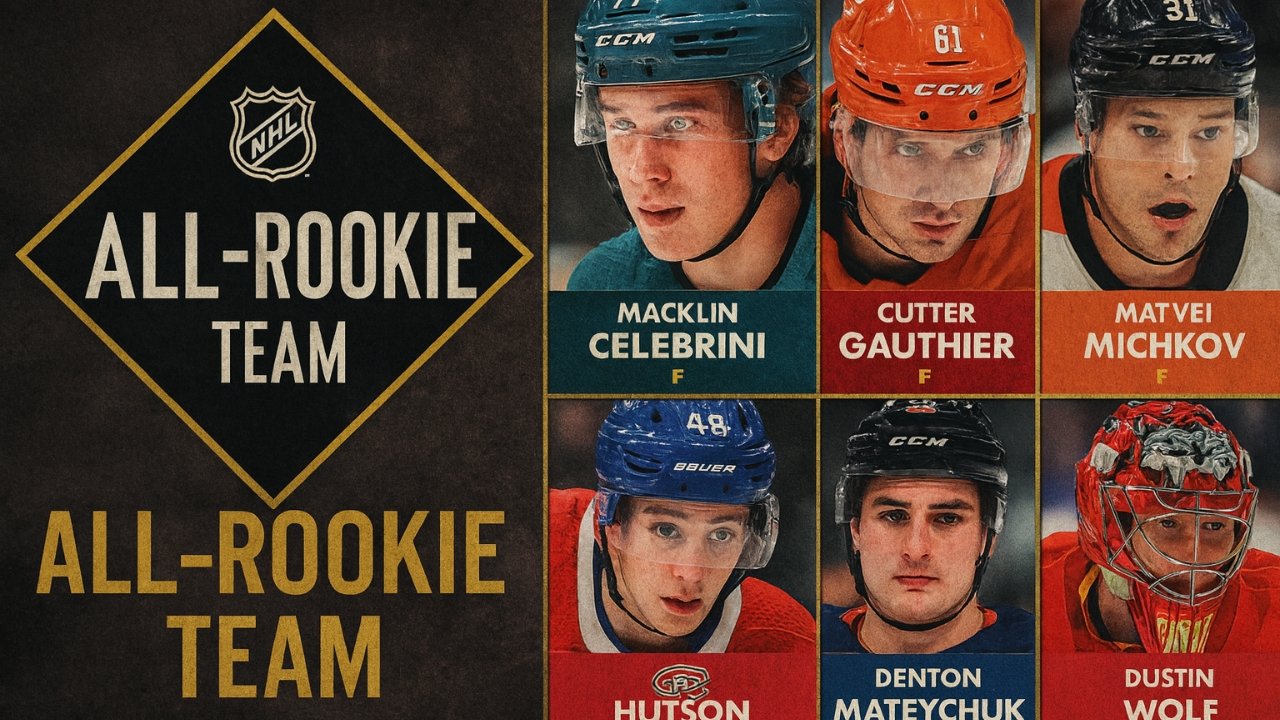The 2025–26 Calder Trophy field blends elite skill with genuine opportunity, featuring ten rookies poised to make an impact from opening night onward. What separates this group is the variety of paths to value: dynamic play drivers on the blue line who can add instant offense, high-IQ wingers ready to feed or finish in the top six, a workhorse goaltender with a clear runway, and power forwards whose north–south games translate immediately. Deployment will shape the race—power-play access, quality of linemates, and coaches’ willingness to live with rookie mistakes—but the talent base is broad enough that multiple contenders could stay in the hunt into spring.
Ivan Demidov, Montreal Canadiens — The Headliner
Demidov brings deceptive entries, slick hands, and true dual-threat offense. He can transport the puck through layers, draw defenders, and either beat goalies clean or slide passes into high-danger space. If he lands stable top-six minutes and early power-play touches, his creativity and timing give him as high a ceiling as any first-year skater, with point production that can scale quickly as chemistry forms.
Zayne Parekh, Calgary Flames — The Power-Play Catalyst
Parekh is a modern right-shot defender who attacks in layers: head-up retrievals, quick outlets through the middle, and a knack for joining as a fourth attacker. Calgary can insulate his defensive minutes early while letting his puck-moving and shot threaten on the man advantage. If he drives clean exits and adds second-wave power-play punch, he’ll rack up the kind of counting stats few rookie defensemen reach.
Sam Rinzel, Chicago Blackhawks — The Transition Engine
Rinzel’s length, glide, and poise give Chicago a right-side mover who can turn defensive stands into rush chances. He doesn’t need a featured role to be effective; tight gaps, simple first passes, and confident carries can stabilize a young blue line. As responsibility grows, so will the quiet points from secondary assists and controlled-entry sequences he starts.
Zeev Buium, Minnesota Wild — The Play-Driver from the Back End
Buium thrives on deception and instant read-and-release decisions. He beats forechecks with body-positioning and shoulder checks, then hits the middle with pace. Minnesota can use him in a sheltered top-four role and still unlock value on entries and the second power-play unit. If the shot and patience translate, he’s a steady box-score presence without heavy offensive-zone coddling.
Matthew Schaefer, New York Islanders — The Fast-Tracked No. 1
Schaefer’s composure under pressure—bait, slip, deliver—fits an Islanders group that needs cleaner breakouts. Even with tempered minutes early, he projects to earn trust quickly because he keeps plays alive and exits with control. As the season wears on, incremental bumps in usage and special-teams looks could put him in the thick of the conversation despite his age.
Gabe Perreault, New York Rangers — The High-IQ Playmaker
Perreault processes the game at speed: short give-and-goes, touch passes into seams, and quick decisions that keep cycles dangerous. On a skill line, he amplifies linemates by moving defenders a half-step the wrong way. If he sticks in the top nine and sees second-unit power-play time, expect primary assists to arrive before the shot volume catches up.
Yaroslav Askarov, San Jose Sharks — The Workhorse Wild Card in Net
Goaltenders rarely win the Calder, but Askarov’s path is clear: heavy workload on a rebuilding team, explosive movement, and confident hands that can steal points. With volume comes visibility—league-average numbers can look outstanding when they flip close games, and any sustained hot stretch will thrust him into the spotlight.
Jimmy Snuggerud, St. Louis Blues — The North–South Finisher
Snuggerud brings pro-ready details: strong routes through the middle, wall strength, and a heavy release that doesn’t need perfect setups. He can live at five-on-five, hunt soft ice off the rush, and cash rebounds or one-timers. On a team retooling its forward mix, a stable role with a playmaking center yields a realistic path to a 20-goal rookie campaign.
Ryan Leonard, Washington Capitals — The Power Winger with Bite
Leonard’s game blends edge and finish. He drives hard entries, leans on defenders, and arrives on time for second chances. Even in a checking-leaning role, he contributes by tilting the ice; if he forces his way into top-six minutes by midseason, his physicality and shot profile make him a classic dark-horse Calder riser.
Alexander Nikishin, Carolina Hurricanes — The Reliable Minute-Eater
Nikishin brings size, poise, and assertive first passes that fit Carolina’s possession machine. He closes quickly, wins body-stick battles, and gets pucks moving north without fuss. The offense may be modest at first, but top-four usage on a strong team can build a sneaky résumé—on-ice goal share, shot suppression, and enough secondary points to keep him in the broader discussion.
How the Race Could Unfold of Calder Trophy
Expect early surges from the skill wingers and puck-moving defensemen as power-play roles solidify, with a midseason goalie push if Askarov seizes the crease. Demidov has the star tools to run wire-to-wire, Parekh and Buium have blue-line paths to eye-catching totals, and Schaefer’s usage could snowball as confidence builds. The deciding factors will be health, deployment, and who converts strong underlying numbers into points when games tighten after the All-Star break.







